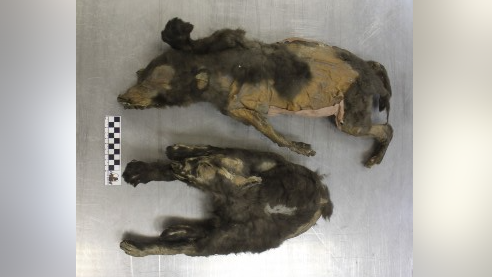Ancient African Cocktail: Beer and a Shot of Antibiotic
About 1,500 years before the modern world discovered the antibiotic tetracycline, North Africans were fermenting and consuming it, probably for most of their lives, according to a chemical analysis of the bones of people who lived along the Nile.
The ancient human remains were recovered near the Sudanese-Egyptian border, where species of tetracycline-producing bacteria inhabit the soil. This region, in Northeastern Africa, was once known as Nubia. Much of it is was flooded when the Nile River was dammed.
The practice of brewing beer was widespread in the region, including in Ancient Egypt to the north, and the researchers think the Nubians fermented Streptomyces or related species with their grain to brew a thick, sour beer spiked with tetracycline. And everyone, from about 2 years old and up, consumed it. [Gallery: Amazing Egyptian Discoveries]
The researchers suspect the Nubians added the bacteria knowing its benefits, though they likely didn't realize the compounds were antibiotics.
"It wasn't a one-time event, because it was all throughout their bones," said Mark Nelson, senior director of chemistry at Paratek Pharmaceuticals, Inc., and an expert in tetracyclines. He performed the chemical analysis on bones from several individuals, which revealed significant amounts of tetracycline.
Ancient medicine
This finding has been decades in the making. The first evidence emerged in 1975, when George Armelagos, now a professor of anthropology at Emory University, was studying the bones and found that under ultraviolet light, a fluorescent yellow-green band appeared on the bones. The phenomenon was known to be evidence of exposure to tetracycline among modern people, but at first Armelagos dismissed it.
Sign up for the Live Science daily newsletter now
Get the world’s most fascinating discoveries delivered straight to your inbox.
A few years later, a graduate student of Armelagos saw the same fluorescent band on bones from the ancient Nubians, and pointed out that tetracycline is a naturally-derived drug. That's when Armelagos realized he had seen what could be evidence of ancient antibiotic use.
"My heart stopped," said Armelagos. "It's like if you were unwrapping a mummy and you saw Ray-Ban sunglasses."
The modern world discovered tetracycline in 1948, about 20 years after the first antibiotic, penicillin, was isolated, according to Nelson, an editor of "Tetracyclines in Biology, Chemistry and Medicine" (Birkhäuser Basel, 2002).
After years of searching soils for micro-organisms that produced compounds toxic to disease-causing bacteria but safe for humans, a soils microbiologist named William Albrecht found a bronze-colored colony of bacteria in a Missouri hay field. Dubbed Streptomyces aureofaciens, it yielded the first tetracycline, called auereomycin, which, to researchers' delight, inhibited the growth of a wide range of bacteria. Auereomycin became the first broad-spectrum antibiotic, according to Nelson.
But Armelagos' initial report, in 1981, that these ancient Nubians may have intentionally used tetracycline, sparked controversy, he said. Critics claimed the yellow-green label originated after the people died, as the result of decay.
Armelagos said attempts to extract the tetracycline from the remains were unsuccessful, until Nelson offered to help out. Nelson, a medicinal chemist, used a colorless, poisonous, and highly corrosive acid – hydrogen fluoride – to dissolve the bones and essentially extract the tetracycline to prove it was the source of the label.
"This is the first real, definitive demonstration that this is tetracycline," Armelagos said.
Not in your liquor store
There was also the question of whether these people intended to consume the tetracycline, or if the label came from moldy grain eaten out of necessity.
"When we first found this, I just assumed that they were consuming this as a famine food," Armelagos said. But he has found that 90 percent of this group of Nubians had bones labeled with tetracycline, and that the evidence for the antibiotic was so extensive that the exposure was unlikely to have been accidental.
The ancient Egyptian practice of brewing beer, documented through archeology and ancient art, is believed to have been a long-standing practice in the region at the time. Brewing beer using fermentation mixtures containing Streptomyces, which excrete tetracycline, appeared to be the only way these people could have produced the quantity of the antibiotic necessary to explain the fluorescent signal, according to Armelagos. So they likely intentionally added the bacteria to their fermenting brews.
Evidence of tetracycline, though in smaller amounts, has also been found in Egyptians, Jordanians and Christians to the south, he said.
In addition to producing an alcoholic buzz, this ancient beer spiked with tetracycline would have cleared up bacterial infections and their symptoms, like diarrhea, as well as killed off harmful bacteria in the brew. Although it's not yet clear how much tetracycline the people consumed regularly – Armelagos thinks it's more than the dosage required to prevent acne – it appeared to have some side effects, including reducing bone loss among older women and increasing iron-deficiency.
The brew would not be appealing to modern beer drinkers.
"We talk about this as a beer; it's not a Heineken or Bud Light," he said. Armelagos had his graduate student brew it once, describing the result as a sour porridge.
"They said it's not bad. That's, I think, the best you can say about it," Armelagos said.
Their work was published in the September issue of the American Journal of Physical Anthropology.

